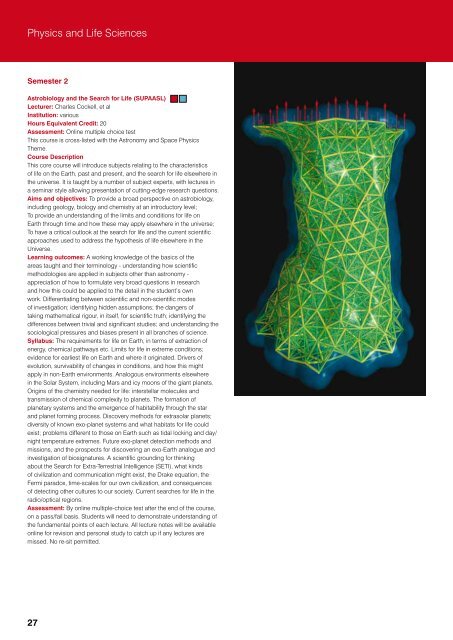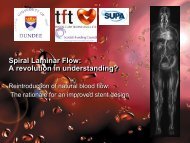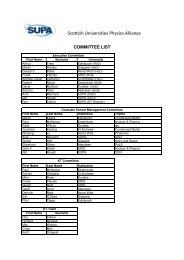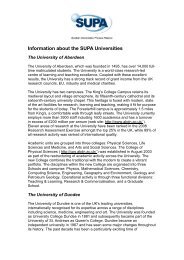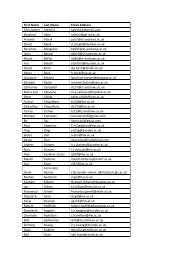Catalogue of Courses & Student Handbook - SUPA
Catalogue of Courses & Student Handbook - SUPA
Catalogue of Courses & Student Handbook - SUPA
You also want an ePaper? Increase the reach of your titles
YUMPU automatically turns print PDFs into web optimized ePapers that Google loves.
Physics and Life Sciences<br />
Semester 2<br />
Astrobiology and the Search for Life (<strong>SUPA</strong>ASL)<br />
Lecturer: Charles Cockell, et al<br />
Institution: various<br />
Hours Equivalent Credit: 20<br />
Assessment: Online multiple choice test<br />
This course is cross-listed with the Astronomy and Space Physics<br />
Theme.<br />
Course Description<br />
This core course will introduce subjects relating to the characteristics<br />
<strong>of</strong> life on the Earth, past and present, and the search for life elsewhere in<br />
the universe. It is taught by a number <strong>of</strong> subject experts, with lectures in<br />
a seminar style allowing presentation <strong>of</strong> cutting-edge research questions.<br />
Aims and objectives: To provide a broad perspective on astrobiology,<br />
including geology, biology and chemistry at an introductory level;<br />
To provide an understanding <strong>of</strong> the limits and conditions for life on<br />
Earth through time and how these may apply elsewhere in the universe;<br />
To have a critical outlook at the search for life and the current scientific<br />
approaches used to address the hypothesis <strong>of</strong> life elsewhere in the<br />
Universe.<br />
Learning outcomes: A working knowledge <strong>of</strong> the basics <strong>of</strong> the<br />
areas taught and their terminology - understanding how scientific<br />
methodologies are applied in subjects other than astronomy -<br />
appreciation <strong>of</strong> how to formulate very broad questions in research<br />
and how this could be applied to the detail in the student’s own<br />
work. Differentiating between scientific and non-scientific modes<br />
<strong>of</strong> investigation; identifying hidden assumptions; the dangers <strong>of</strong><br />
taking mathematical rigour, in itself, for scientific truth; identifying the<br />
differences between trivial and significant studies; and understanding the<br />
sociological pressures and biases present in all branches <strong>of</strong> science.<br />
Syllabus: The requirements for life on Earth, in terms <strong>of</strong> extraction <strong>of</strong><br />
energy, chemical pathways etc. Limits for life in extreme conditions;<br />
evidence for earliest life on Earth and where it originated. Drivers <strong>of</strong><br />
evolution, survivability <strong>of</strong> changes in conditions, and how this might<br />
apply in non-Earth environments. Analogous environments elsewhere<br />
in the Solar System, including Mars and icy moons <strong>of</strong> the giant planets.<br />
Origins <strong>of</strong> the chemistry needed for life: interstellar molecules and<br />
transmission <strong>of</strong> chemical complexity to planets. The formation <strong>of</strong><br />
planetary systems and the emergence <strong>of</strong> habitability through the star<br />
and planet forming process. Discovery methods for extrasolar planets;<br />
diversity <strong>of</strong> known exo-planet systems and what habitats for life could<br />
exist; problems different to those on Earth such as tidal locking and day/<br />
night temperature extremes. Future exo-planet detection methods and<br />
missions, and the prospects for discovering an exo-Earth analogue and<br />
investigation <strong>of</strong> biosignatures. A scientific grounding for thinking<br />
about the Search for Extra-Terrestrial Intelligence (SETI), what kinds<br />
<strong>of</strong> civilization and communication might exist, the Drake equation, the<br />
Fermi paradox, time-scales for our own civilization, and consequences<br />
<strong>of</strong> detecting other cultures to our society. Current searches for life in the<br />
radio/optical regions.<br />
Assessment: By online multiple-choice test after the end <strong>of</strong> the course,<br />
on a pass/fail basis. <strong>Student</strong>s will need to demonstrate understanding <strong>of</strong><br />
the fundamental points <strong>of</strong> each lecture. All lecture notes will be available<br />
online for revision and personal study to catch up if any lectures are<br />
missed. No re-sit permitted.<br />
Physics and Life Sciences<br />
27


